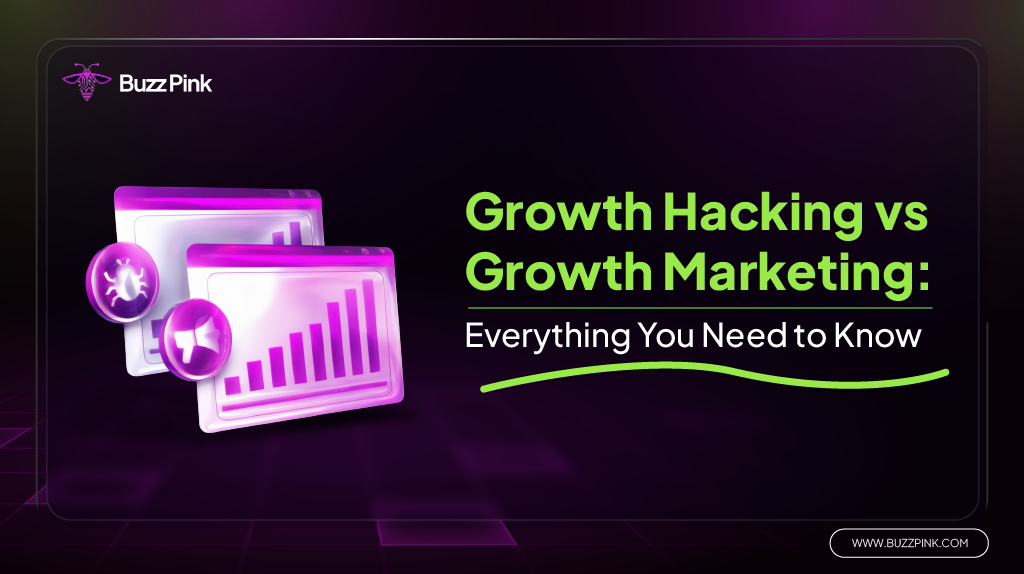Everyone will do anything to make it work in the business world, whether it’s through hacking or a thorough marketing strategy. Don’t get it wrong, hacking isn’t always a bad thing. After all, both growth hacking and growth marketing have the same ultimate goal: to acquire customers and keep the business running.
Growth hacking and growth marketing are two well-known and commonly used marketing strategies, particularly for startups. Although they both have the same goal, their operations and implementations differ. To clear up any confusion, we’ll explain the differences between growth hacking vs growth marketing.
What Is Growth Hacking?
 Growth hacking is a marketing plan that prioritizes speedy development utilizing creative and extraordinary tactics with minimal resources and budget. Apart from the fact that it is low-cost, it generates fruitful and influential results, hence the name “growth hacking.”
Growth hacking is a marketing plan that prioritizes speedy development utilizing creative and extraordinary tactics with minimal resources and budget. Apart from the fact that it is low-cost, it generates fruitful and influential results, hence the name “growth hacking.”
Read More: How to Integrate SEO and User Experience for Better Website Performance
This strategy is most commonly used by newly established startups looking for recognition without having to burn money. For example, it could be implemented as a small invitation feature that rewards customers for sharing it with their friends.
How Does Growth Hacking Work
Growth hacking initially starts with an intense study of the targeted audience. The hackers must learn about their audience’s behavior, needs, and desires in order to generate creative ideas that can meet all three through a product or service.
After developing an idea, the hackers will put it into action right away while collecting data throughout the trial. If the strategy works, they will continue with it; if it fails, they will abruptly stop and seek alternative solutions. Growth hacking is the process of conducting one trial after another using creativity and data.
The Benefits and Drawbacks of Growth Hacking
Growth hacking, like two sides of a coin, has both benefits and drawbacks. This strategy may be appropriate in some situations, but it is unlikely to be effective for businesses seeking long-term stability and sustainability. The key is to gain a thorough understanding of this strategy before deciding whether or not it is right for you.
Benefits of Growth Hacking
- Rapid Growth
Growth hacking is designed to produce immediate results. Consider a referral feature that can double rewards if a user successfully invites one person to join. The rewards can multiply, benefiting not only the user but also the business that implements this strategy.
- User Acquisition
The main goal of a growth hacker is to get as many customers as possible to try out their product or service. This makes the goal easier to achieve because the hacker does not have to plan for a long-term strategy or how to keep it sustainable once enough clicks are generated. All they have to think about is how to acquire users.
- Based on Data
Each trial is monitored using data, such as how many users registered, how many returned, how long they spent on the website, and so on. So, even though the procedure is quick and jumps from one strategy to the next, it isn’t a meaningless “fool around and see what happens.” Each decision is supported by solid data.
- Low Cost
Many hacking strategies are cost-effective, and in some cases free. It can be easily implemented by including a “promotion, grab it fast!” message in marketing emails or social media feeds. Simply lower the price of your product or service slightly, and a swarm of customers will arrive.
Drawbacks of Growth Hacking
- Short-Term
Considering that growth hacking concentrates solely on strong development and results, the impact is most likely short-lived. After one strategy has been successful, the hacker must seek out another creative idea.
- Less Planned Strategy
Growth hackers must develop multiple strategies at the same time as a backup plan so that if one fails, they can quickly switch to the next. This makes the planned strategies less detailed because their only goal is to attract a large number of customers.
- Tactic Not Universally Applicable
Not every tactic is applicable to every business. What works in one company does not necessarily work in another. This makes growth hackers prone to feeling overwhelmed because they must consider multiple plans at once.
What Is Growth Marketing?
 Growth marketing refers to a fully integrated and long-lasting marketing plan. Its ultimate goal encompasses a wide range of objectives, including attracting customers, ensuring their continued use of the product or service, and convincing them to recommend it to others.
Growth marketing refers to a fully integrated and long-lasting marketing plan. Its ultimate goal encompasses a wide range of objectives, including attracting customers, ensuring their continued use of the product or service, and convincing them to recommend it to others.
This strategy combines brand marketing and digital marketing to maximize company development. Making the brand known through digital promotion increases the likelihood of a stable and long-term outcome.
How Does Growth Marketing Work
A growth marketer develops a long-term strategy, such as creating educational content, sending emails on a regular basis, or broadcasting information on social media. All of this is intended to reassure customers that the product or service is truly beneficial and worth the money.
After customers have purchased the product or service, the marketer will analyze their subsequent behavior, such as what they like about the product, which features they use the most frequently, and so forth. With enough data, the marketer will create a strategic plan to keep customers using the product, repurchasing it, and even recommending it to others.
Benefits and Drawbacks of Growth Marketing
Unlike hacking, which is spontaneous and quick, growth marketing requires time and a thoughtful plan. Although it requires more resources, the end result is guaranteed for the long term.
Benefits of Growth Marketing
- Sustainable Development
Growth marketing is concerned with achieving a lasting impression. This ensures that business owners are not constantly on alert but rather remain safe and steady. They do not need to create a new plan every month to keep the business afloat.
- Spot On Audience
Growth marketers understand the issues and solutions, and because the plan is the result of extensive analysis and brainstorming, the target audience is more likely to be correct.
- Increase in Retention
Long-term business plans imply that the relationship does not end with the purchase. Growth marketers must stay in touch with their customers by sending a thank you card that encourages open feedback. It’s more than just a formality, the marketers must act on feedback so that customers feel heard and seen, making them more likely to stay.
- Long-Term ROI
To be effective, a growth marketing strategy requires a significant amount of time and resources. However, great efforts are accompanied by great results. This strategy is intended to keep loyal customers, resulting in a long-term return on investment.
Drawbacks of Growth Marketing
- Long Process
Unlike hacking, which is quick and produces immediate results, growth marketing requires patience. The marketers must carefully design the system, conduct extensive customer research, and create high-quality content to ensure customer satisfaction and loyalty. All of these do not happen overnight, it is a long process.
- Huge Team and Resources
Because it is a well-planned strategy, it cannot be developed by just one brain. It takes a full team to ensure that all aspects can be properly executed and achieved over the long term. They must also monitor development, which consumes a large amount of resources.
The Difference Between Growth Hacking vs Growth Marketing
 The main distinction between growth hacking and growth marketing is in their approaches. Growth hacking feels like sprinting on a jogging track. The action will undoubtedly make people’s heads turn in an instant. Meanwhile, growth marketing is like running a long marathon. You don’t just sprint to the finish line, you have to calculate your stamina to make it there. You may be slower, but you will certainly win.
The main distinction between growth hacking and growth marketing is in their approaches. Growth hacking feels like sprinting on a jogging track. The action will undoubtedly make people’s heads turn in an instant. Meanwhile, growth marketing is like running a long marathon. You don’t just sprint to the finish line, you have to calculate your stamina to make it there. You may be slower, but you will certainly win.
Growth hacking has only one ultimate goal, which is to attract new customers. However, growth marketing has a number of objectives that must be met, including attracting new customers, keeping them connected, converting them into loyal customers, and even getting them to recommend the product to others. In summary, growth marketing is more comprehensive and thorough.
The Similarities Between Growth Hacking and Growth Marketing
Although their approaches differ, they both share one common goal: to grow the business. The two, hacker and marketer, use data to make decisions, conduct experiments, and collaborate with each position on their team.
Furthermore, both pay special attention to their customers because if they are satisfied, they will continue to use the product or service and even recommend it to others. Although that is not the goal of growth marketing, it does not hurt to gain loyal customers in the process.
When to Use Growth Hacking vs Growth Marketing for Maximum Impact
If you’re a new startup looking for customers and have a limited budget, growth hacking may be the right choice. You can attract a large number of customers in a short period of time using only the most basic resources and creative thinking.
However, if you already have a product or service in the market and want to achieve long-term stability, growth marketing is the best strategy to use. You can establish a long-term relationship with customers and encourage them to develop loyalty.
Read More: SEO and SEM: What’s the Difference and Why It Matters
Ideally, you can use both strategies at once. Growth hacking can be used for immediate results, such as when launching a new product. Then you can combine it with a growth marketing strategy to maintain a stable number of purchases.
Looking for a Growth Hacking or Growth Marketing Team?
At Buzz Pink, we don’t just sell strategies, we build development engines. Whether you need the fast, creative wins of hacking or the long-term sustainability of marketing, our team does both, and we do it with numbers to back it up.
We’ve launched viral Web3 campaigns, built SEO machines that pull 30K+ organic traffic monthly, and scaled brands from zero to hero without wasting a cent. From referral loops and social virality to retention funnels and high-converting content, we combine bold experimentation with a data-driven structure so your brand grows fast and keeps growing.
If you’re ready to break out of average and scale with a team that understands both rapid hacks and lasting strategy, it’s time to talk to Buzz Pink. One team. Two development engines. Zero wasted budget. Let’s build the brand they won’t forget now with Buzz Pink.
Conclusion
Growth hacking vs growth marketing? They don’t have to be mutually exclusive. Rather, they can complement one another. Growth hacking is best suited for the early stages of rapid development. However, in the long run, growth marketing serves as a solid foundation to prevent the business from collapsing.
Instead of deciding on one, the question should be, “How do I develop a sustainable development strategy that is appropriate for my business?” You can take your business to the next level by combining the speed of hacking with the power of marketing strategies.
Kamila Putri is a content strategist and digital marketing expert who helps brands craft messages that resonate and drive results. With a strong foundation in SEO, brand voice, and data-driven strategy, she has produced content that performs, whether it's optimized web copy, lead-generating campaigns, or conversion-focused messaging. At Buzz Pink, she applies this expertise to help clients grow through smart, search-focused digital strategies that engage, inform, and convert.


